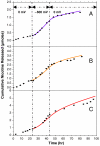Programmable transdermal drug delivery of nicotine using carbon nanotube membranes
- PMID: 20547880
- PMCID: PMC2900688
- DOI: 10.1073/pnas.1004714107
Programmable transdermal drug delivery of nicotine using carbon nanotube membranes
Abstract
Carbon nanotube (CNT) membranes were employed as the active element of a switchable transdermal drug delivery device that can facilitate more effective treatments of drug abuse and addiction. Due to the dramatically fast flow through CNT cores, high charge density, and small pore dimensions, highly efficient electrophoretic pumping through functionalized CNT membrane was achieved. These membranes were integrated with a nicotine formulation to obtain switchable transdermal nicotine delivery rates on human skin (in vitro) and are consistent with a Fickian diffusion in series model. The transdermal nicotine delivery device was able to successfully switch between high (1.3 + or - 0.65 micromol/hr-cm(2)) and low (0.33 + or - 0.22 micromol/hr-cm(2)) fluxes that coincide with therapeutic demand levels for nicotine cessation treatment. These highly energy efficient programmable devices with minimal skin irritation and no skin barrier disruption would open an avenue for single application long-wear patches for therapies that require variable or programmable delivery rates.
Conflict of interest statement
Conflict of interest statement: US Patent 7,229,556 (2007) issued to the University of Kentucky.
Figures



Similar articles
-
A preclinical evaluation of a programmable CNT membrane device for transdermal nicotine delivery in hairless Guinea pigs.J Control Release. 2019 Jan 10;293:135-143. doi: 10.1016/j.jconrel.2018.07.003. Epub 2018 Jul 7. J Control Release. 2019. PMID: 29990525
-
Programmable carbon nanotube membrane-based transdermal nicotine delivery with microdialysis validation assay.Nanomedicine. 2017 Jan;13(1):1-9. doi: 10.1016/j.nano.2016.06.017. Epub 2016 Jul 18. Nanomedicine. 2017. PMID: 27438911
-
Programmable transdermal delivery of nicotine in hairless guinea pigs using carbon nanotube membrane pumps.J Pharm Sci. 2012 Oct;101(10):3823-32. doi: 10.1002/jps.23240. Epub 2012 Jul 17. J Pharm Sci. 2012. PMID: 22806243
-
Transdermal Nicotine. A review of its pharmacodynamic and pharmacokinetic properties, and therapeutic efficacy as an aid to smoking cessation.Drugs. 1992 Sep;44(3):498-529. doi: 10.2165/00003495-199244030-00011. Drugs. 1992. PMID: 1382940 Review.
-
Towards mimicking natural protein channels with aligned carbon nanotube membranes for active drug delivery.Life Sci. 2010 Apr 10;86(15-16):563-8. doi: 10.1016/j.lfs.2009.04.006. Epub 2009 Apr 18. Life Sci. 2010. PMID: 19383500 Free PMC article. Review.
Cited by
-
A smart temperature and magnetic-responsive gating carbon nanotube membrane for ion and protein transportation.Sci Rep. 2016 Aug 18;6:32130. doi: 10.1038/srep32130. Sci Rep. 2016. PMID: 27535103 Free PMC article.
-
Design of Nano Screw Pump for Water Transport and its Mechanisms.Sci Rep. 2017 Feb 3;7:41717. doi: 10.1038/srep41717. Sci Rep. 2017. PMID: 28155898 Free PMC article.
-
Transdermal electroosmotic flow generated by a porous microneedle array patch.Nat Commun. 2021 Jan 28;12(1):658. doi: 10.1038/s41467-021-20948-4. Nat Commun. 2021. PMID: 33510169 Free PMC article.
-
Electrophoretically induced aqueous flow through single-walled carbon nanotube membranes.Nat Nanotechnol. 2012 Jan 15;7(2):133-9. doi: 10.1038/nnano.2011.240. Nat Nanotechnol. 2012. PMID: 22245860 Free PMC article.
-
Release of an Encapsulated Peptide from Carbon Nanotubes Driven by Electric Fields: A Molecular Dynamics Study.ACS Omega. 2021 Oct 6;6(41):27485-27490. doi: 10.1021/acsomega.1c04436. eCollection 2021 Oct 19. ACS Omega. 2021. PMID: 34693169 Free PMC article.
References
-
- Food and Drug Administration. Approved Drug Products with Therapeutic Equivalence Evaluations. 27th Ed. Rockville, MD: Department of Health and Human Services; 2007.
-
- Manchikanti L. National drug control policy and prescription drug abuse: Facts and fallacies. Pain Physician. 2007;10:399–424. - PubMed
-
- Wills S. Drugs of Abuse. London: Pharmaceutical Press; 2005.
-
- Prausnitz MR, Mitragotri S, Langer R. Current status and future potential of transdermal drug delivery. Nat Rev Drug Discov. 2004;3:115–124. - PubMed
Publication types
MeSH terms
Substances
Grants and funding
LinkOut - more resources
Full Text Sources
Other Literature Sources

